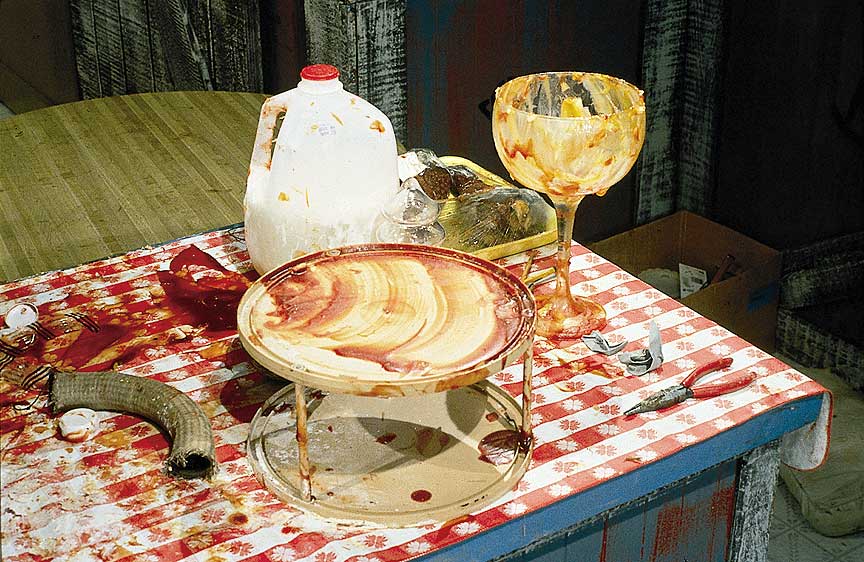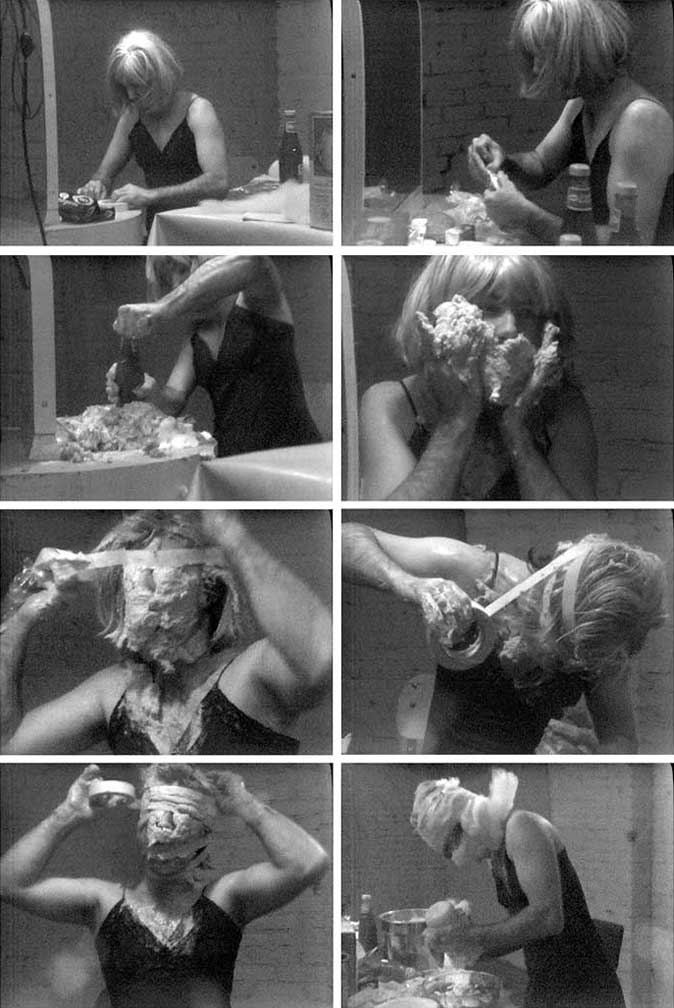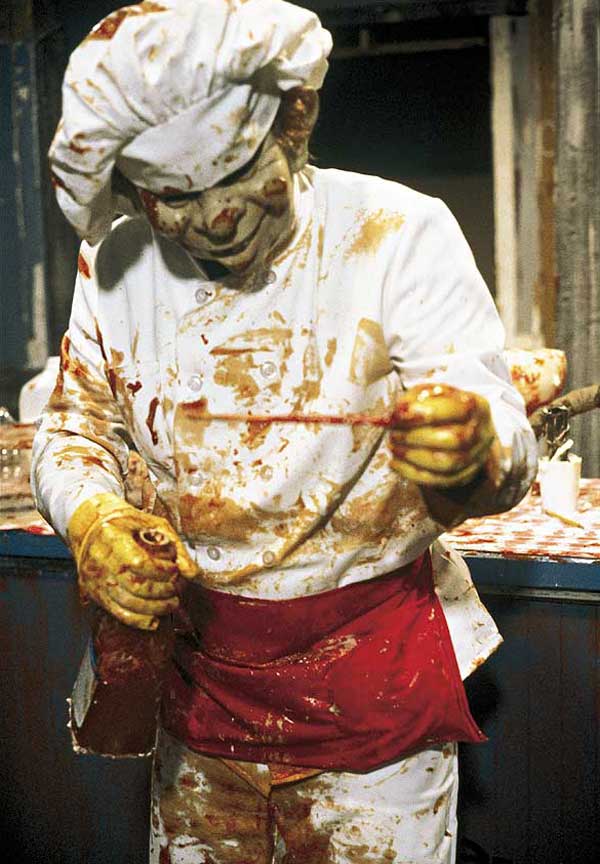Interview
Laughing His Way Into Character

Production still from the "Art in the Twenty-First Century" Season 5 episode, "Transformation," 2009. © Art21, Inc. 2009.
In this interview, conducted in Los Angeles in 2009, Paul McCarthy discusses his videos, from early productions like Ma Bell (1971) up through later works like Bossy Burger (1991).
McCarthy: In the late 1960s, I got really interested in making videos. The problem was getting hold of the equipment. At that time, you could find it in some high schools and dental schools, but not in art departments. I moved to Los Angeles from San Francisco because I got accepted into the University of Southern California (USC), which had a multimedia department. They let students work between the art department and film school. I had the idea that I would make videotapes when I got to USC.
Art21: Why were you interested in making videos at that point?
McCarthy: I had made films for a while. But film had all of these inherent difficulties. You had to shoot the film and make sure the exposure was correct. Also, reels were short, like three minutes. Having a video camera that could shoot for an extended period of time, continuously, was a big deal. You also had sound and you could see the image right then and there—all of this seemed liked another dimension that film didn’t have. I was also interested in experimental film and the cross over between art and Hollywood. I thought that by being near Hollywood I would have access to equipment I couldn’t otherwise get. I was interested in this new thing, this future medium.
But it turned out that USC was super conservative. You had to develop a script before you could make a film. I was coming from an art background and not really interested in narrative. The only people who got to be hands-on with the equipment at USC were certain privileged graduate students who had already written their scripts. The experience with the film school was a disaster. Then an interesting thing happened: the beginning of CalArts. They hired a number of people to teach video, including Nam June Paik and Wolfgang Stoerchle. I ended up borrowing equipment from CalArts. And then I made arrangements with the video technician at USC’s dental school. So my videotapes start happening in 1970.
One of my first tapes is of me just spinning. I would be in a room and start rocking and then I sort of intuitively started spinning. I tried to get up to thirty minutes and then an hour of spinning. Most of the videotapes in the beginning were very minimal, just me spinning or rolling on the floor, one action repeated over and over, or they were task oriented. Ma Bell (1971) was done at the same time that all of these tapes were done.

Paul McCarthy. Bossy Burger, 1991. BBQ turkey leg, television, stage set, bowls, cooking utensils, chair, counter, milk, flour, ketchup, mayonnaise, dolls, chef costume, rubber Alfred E. Neuman mask, and video; dimensions variable. Performance, video, and installation at Rosamund Felsen Gallery, Los Angeles. © Paul McCarthy. Courtesy of Hauser & Wirth, Zürich London
Art21: Tell me about Ma Bell.
McCarthy: I was working in a seven-story building called the Broadway Building. It was owned by the city and they had lent it to USC. I was the only graduate student who moved to the building—the rest of the students stayed in a studio down by the campus—so I had the whole building to do whatever I wanted. The city was storing a bunch of stuff there and had an entire floor of telephone books. I grabbed one of the telephone books and said to the guys who I had started filming with that I was going to make a video in which I covered the pages of the telephone book in motor oil, kind of like a painting. I had been making paintings using black motor oil and another work using cotton, so the materials were already there. Something critical happened: I started to laugh this hysterical laugh and it became way more performative. I wasn’t just covering the book with oil, but pounding on the pages and laughing this insane laugh. You only see me from the neck down in this video. That you didn’t see my face, the face of the artist, was somewhat new. It’s one of the first pieces where a persona happens. In other videos the persona usually starts with a mask or involves covering the face and head. But in Ma Bell the laughter is the persona.
Art21: Was the laugh spontaneous?
McCarthy: It was spontaneous. I think I had decided on the way up the elevator what I was going to do. I thought it would be static and quiet, just me painting a book with cotton as a brush and the motor oil as paint. I didn’t think I would laugh, but I started laughing and then I exaggerate my laugh. It became the expression of a kind of mad persona and insane painting.
Art21: The late 1960s was a great time for improvisational theatre. Did that influence you?
McCarthy: I knew about The Living Theatre and I’d seen them live. And, of course, during the Vietnam War there were all kinds of theatre as political demonstration. I was aware of Jean Genet and Antonin Artaud, and I was certainly aware of Kaprow’s Happenings and Gutai and Kudo and all that. But I’d never really seen any of it; I had just seen images in magazines. I don’t know if those were as influential as my paintings. In the 1960s, I had painted paintings with my hands, flat on the ground. I would light them on fire and burn them. It was like a flash fire that would turn them completely black. The reason for painting flat on the ground was practical not formal: I could pour gasoline on the surface and it would stay on the surface. I didn’t think of these as performance or theatre, but there was this action aspect to them. It was sort of spontaneous, like I went into character.

Paul McCarthy. Meat Cake #3, 1974. Performance, video, black-and-white and color photographs; 35:09 minutes. Videography by Mike Cram. Courtesy of Hauser & Wirth. © Paul McCarthy.
Art21: Did you make performances of some kind as a kid or give yourself tasks that could have been considered performance?
McCarthy: I was kind of a class clown, so there was always a performance of some sort when I was in school. But I’ve never really equated that with the performance work I did in the 1960s and 1970s.
Art21: Tell me about your performances in the 1970s.
McCarthy: The 1970s was a period when my performances and videos developed and evolved. The performances go from Ma Bell to pieces like Sailor’s Meat (1975) to this period when I start using wigs and costumes. The rubber masks happened in the mid-1970s. There was a period of patriarchs and animals—grandfather masks from The Texas Chainsaw Massacre and pigs referring to Miss Piggy. Then I went into this Popeye and Olive Oyl thing. I would go to gag and costume stores on Hollywood Boulevard where they would have racks of cheap rubber masks. They would have a kind of stock mask year after year, but they would also have masks based on the latest celebrity, Madonna or the current president or whoever. I would just pick one off the wall.
By the early 1980s, I’m doing twelve or more performances a year. Around 1983 the art world changed. Reagan and Reaganomics happened. And performance art went from being about actions in different locations to alternative spaces painting their spaces black, hanging lights, and building stages. Performance became more cabaret. I became less interested in performance and more interested in setting up a situation that I could videotape. I was interested in having an audience that peered into something that was actually being made for the camera.

Paul McCarthy. Bossy Burger, 1991. BBQ turkey leg, television, stage set, bowls, cooking utensils, chair, counter, milk, flour, ketchup, mayonnaise, dolls, chef costume, rubber Alfred E. Neuman mask, and video; dimensions variable. Performance, video, and installation at Rosamund Felsen Gallery, Los Angeles. Courtesy of Hauser & Wirth, Zürich London. © Paul McCarthy.
The set for Bossy Burger (1991) actually came from a 1960s TV sitcom called Family Affairs; it was the hamburger stand where the teenagers in the story hung out. I set it up in the gallery and I enclosed it—made it into a room with swinging doors. I referred to the set as a trap: you entered it and you couldn’t get out. Everything around it was void. It floated in a void. We filmed in the gallery. I got a mobile TV truck that had all the editing and switchers in it and we pulled into the back of the gallery with the director and three or four cameras inside. We filmed in one night, edited it in the truck over the next two days, and then put the monitors in the room with the set and showed the tape.
Art21: Talk a little bit more about editing.
McCarthy: In the 1970s, I would isolate moments that made sense to me, but not in an attempt to alter a piece or construct reality. I think editing became more important for me after Bossy Burger (1991). But today I don’t have the time to edit. Editing now means collaborating or working with editors. I give a general idea of what I want and they go off and come back months later. We look at it, maybe make more adjustments, and then they go off again. It’s like how I make sculpture; I work with people. I’m interested in the outcome of a video, but not as critical about the details. I’m more interested in how it flows. I’m interested in the bigger picture.
Interviewer: Susan Sollins. Content Editor: Nicole J. Caruth. Published: August 2013. © Art21, Inc. Artwork Courtesy: Hauser & Wirth.



